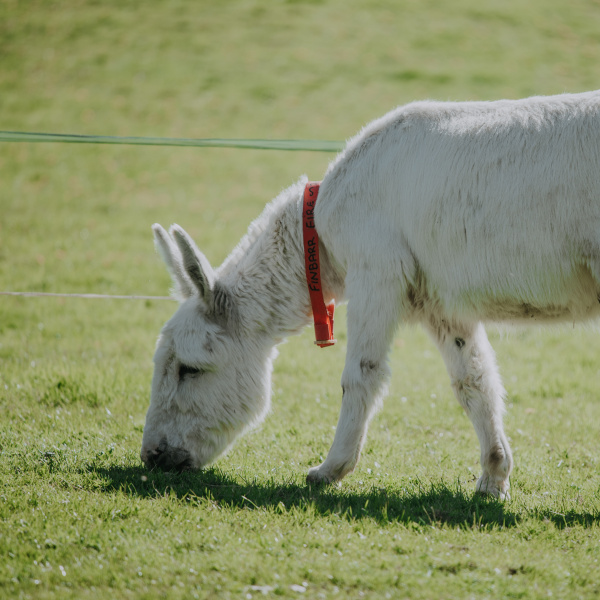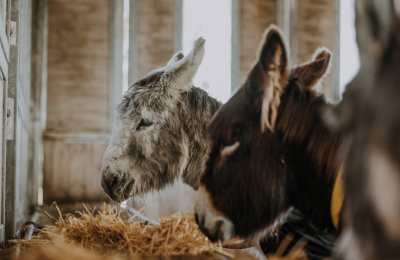Knowing what and how much to feed your donkeys isn't always easy.
We've come up with the answers to your questions about what to feed your donkeys and pasture management to help keep your donkeys fit and healthy.
Can I use a grazing muzzle on my donkey?
Here at The Donkey Sanctuary, we do not advocate the use of grazing muzzles on donkeys. Aside from fitting difficulties due to donkeys’ differently shaped heads, we have found that grazing muzzles are not an effective method of reducing a donkey’s grass intake. Donkeys are very adept problem solvers and are more likely to be able to get out of the grazing muzzle than horses and ponies.
Another risk when using a grazing muzzle with donkeys is that they may become depressed due to the restriction imposed on them and give up trying to eat through the muzzle. This could lead to the development of hyperlipaemia (a life-threatening condition caused by a negative energy balance - see our Hyperlipaemia in donkeys page.
Grazing muzzles also interfere with behaviours other than eating including social interactions such as grooming. There is also the potential risk of permanent damage to the teeth occurring with the use of some grazing muzzles, due to the abnormal abrasion caused from the muzzle itself. Due to these overwhelming factors we strongly advise against the use of grazing muzzles in all donkeys.
Is it safe to feed my donkeys straw?
We recommend feeding straw to the majority of donkeys. The reason being it is close to their natural diet and helps to keep them feeling full, fulfil their need to chew and provides fibre to keep the gut healthy. Donkeys that have lost some teeth may find straw (and hay/haylage/grass) too difficult to chew and in these cases we recommend a chopped fibre alternative. We feed straw to almost all the donkeys, mules, horses and ponies in our care and haven’t seen any increase in impaction colic in these animals due to feeding straw. If your donkey is on box rest consult your vet about feeding straw, as animals with restricted movement can be more at risk of colic.
I don’t have any weigh scales, how can I tell if my donkey is overweight?
There are a few ways that you can keep a record of your donkey’s size and weight without having to use weigh scales. Body condition scoring (BCS) or condition scoring (CS) is a way of assessing body fat coverage both visually and ‘hands on’. Taking heart girth measurements involves measuring the donkey’s circumference around the area where a girth would go (just behind the front legs), this measurement can be recorded and repeated to look for any change in size around the middle. Heart girth measurements can be particularly useful when used in conjunction with a height measurement as you can calculate an approximate weight from the two measurements. Keeping an objective record of your donkey’s body condition, heart girth and approximate weight every month is useful if you are monitoring their weight, or once or twice a year if their weight is stable. For more information on how to do this please see see our Monitoring your donkey's weight page.
Where can I buy donkey safe feeds?
Most horse feed merchants and agricultural suppliers will be able to source our recommended feeds for you. They may not carry them in their normal stock depending on your area but will be able to order them directly from the manufacturers or distributors.
What does my donkey need to eat?
Most healthy, adult donkeys only really need to eat straw plus a little hay/haylage or grass and a vitamin and mineral supplement. Straw should make up the majority of the diet, approx. 75% in the summer and 50% in the winter. Vitamin and mineral supplements may take the form of a forage balancer, or an unmolassed equine specific mineral lick.
What is the difference between hay and haylage?
Hay is dried grass that is baled at approximately 85-90% dry matter. Haylage is also made from dried grass, but instead of being allowed to dry out as much as hay it is semi-dried (50-70% dry matter) and then baled and wrapped in plastic. Wrapping in plastic keeps out oxygen and allows the haylage inside to ferment. This fermentation process breaks down some of the sugars in the haylage and gives it a distinctive sweet smell (but it should never smell ‘off’). Haylage can be a better option for some donkeys but should not be confused with silage which is never suitable for feeding to equines. Remember to always check the energy levels or have your farm produced forage analysed as donkeys should only be fed preserved haylage or hay with an energy level of less than 10 MJ/kg.
Should I feed my donkey any supplements or vitamins?
We don’t generally recommend any dietary supplements are fed to your donkeys unless under the instruction of your vet, with the exception of vitamins and minerals. In our experience, there is little evidence to suggest that most supplements have any beneficial effects. We do recommend that donkeys are given a vitamin and mineral supplement, either in the form of a balancer given once or twice a day, or free access to an equine specific un-molassed lick. There are several different products available on the market, please contact us if you are in any doubt about which would be best for your donkey.
How many feeds should my donkey get a day?
First of all we need to establish whether your donkey does actually need any extra feeds, or whether a forage based diet would be sufficient (as in most cases). If your donkey is elderly, underweight or in foal they may need some additional feed in which case we recommend splitting the total amount per day over at least 2 feeds, and ideally more. It is important to remember that donkeys are trickle feeders and do not tolerate well large ‘bucket’ feeds and subsequent periods of no food intake. For an average donkey we don’t recommend giving more than 1 kg of supplementary feed at a time.
What size paddock does my donkey need?
Donkeys don’t need as much grazing as you might imagine, and depending on the type of pasture you have a one-acre paddock should be sufficient for two donkeys to provide year-round exercise and limited grass. Grazing should be considered an addition to straw, with straw making up the bulk of the diet. Donkeys given unrestricted access to grass are highly likely to become overweight and are at an increased risk of developing laminitis due to the relatively high level of sugars in grass. If you are in any doubt about the suitability of your grazing please contact us for further advice. We can also offer free home visits all over the UK for any donkey owners or carers requiring on-site advice, which is often the best way of giving pasture management guidance.
What is strip grazing?
Strip grazing is a method of restricting grazing using movable electric fencing. The type of electric fencing used for horses is suitable for donkeys, and most donkeys learn very quickly (and without being harmed) to stay away from the fence. Sectioning off the paddock can be done in a number of ways to rotate the area being grazed and to reduce the amount of grass available. Using fenced tracks around the pasture between features such as shelter, feed, water and shade can be particularly useful to provide motivation to move around throughout the day. Reducing the area of grazing available is always more effective than reducing time at grass, as donkeys very quickly learn to gorge themselves on restricted time.

